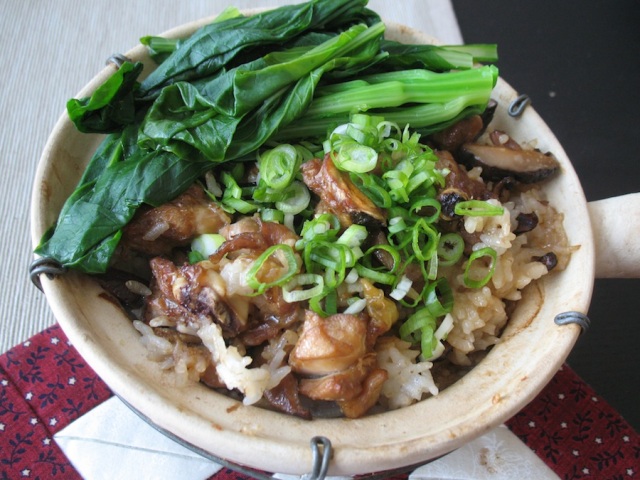 Rice cooked in earthenware pots is a specialty in various places throughout China, but the dish is particularly well known in Hong Kong and broader Guangdong, by the name baozai fan 煲仔飯 (also written 堡仔飯, and pronounced bozei faan in Cantonese). When I was a student in Guangzhou, this was one of those go-to meals that was crucial at least once a week, like Guilin mifen. Also like the Guilin mifen shops/restaurants, baozai fan places did mostly just that one dish, with a variety of choices for toppings.
Rice cooked in earthenware pots is a specialty in various places throughout China, but the dish is particularly well known in Hong Kong and broader Guangdong, by the name baozai fan 煲仔飯 (also written 堡仔飯, and pronounced bozei faan in Cantonese). When I was a student in Guangzhou, this was one of those go-to meals that was crucial at least once a week, like Guilin mifen. Also like the Guilin mifen shops/restaurants, baozai fan places did mostly just that one dish, with a variety of choices for toppings.
This dish is prepared in a single-serving earthenware pot, or shaguo 砂鍋, along with chosen toppings. Here are a couple of great pictoral examples of this dish from Hong Kong, from Terina and Tim, and from HKepicurious.
You can find earthenware pots like these at the larger China-focused markets. The Underground market in Chinatown and the large kitchen stores there will have options. The big markets on Washington avenue, Hung Vuong and Big 8 Market will have them too. Here are some examples that I’ve collected over the years. Some pots are glazed only on the inside:
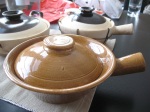
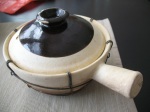
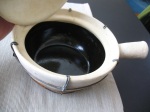
This dish is pretty simple to put together, with the greatest challenge being the same as cooking a great rice pilaf (like the Persian polo recently posted at Fae’s Twist and Tango, or like my Uyghur polo, for example): provide that the rice is cooked fully and evenly, and that the bottom of the rice is crispy and chewy (without the rice overcooking).
This appreciation for crispy rice on the bottom spans across Eurasia, from Iran all the way to Korea (see here for a wiki on the Korean crispy rice that can be made into soup, nurungji 누룽지).
Tips toward a perfect rice: one way to help ensure the rice cooks through evenly is to pre-soak the rice for at least 1/2 hour. I usually use short grain East Asian rice (i.e. Japanese rice used for sushi). Many cooks and recipes say you shouldn’t stir the rice while it is cooking. I usually do a bit at the beginning of the cooking process, but once it starts to boil and set, don’t stir. It will help that crisp layer on the bottom to form. Another trick is to use a heat diffuser between your pot and the flame or heating element. If you do, you can drop the heat way down at the end if the rice is already crisping and not cooking through. With this method you can sprinkle a little water on top and let it sit on very low heat for another 10 minutes or so to cook through.
Most shops have a variety of marinated toppings (usually meat or fish) that will go into the clay pot once the rice has set, about 10 minutes or less into cooking. The marinade liquids will also help to give nice flavor to the crust on the bottom of the pot. Classic versions of the clay pot dish include chopped chicken (with bone-in) with mushrooms, sausage and smoked meats, marinated meat and egg.
Finally, once the toppings are cooked and the rice is cooked through, shops often top the dish off with a blanched long leaf vegetable, chopped green onions, and a generous splash of soy sauce.
This is a real comfort food, and it is great for dinner on a cool evening.
Here is a recent attempt at a bony chicken with mushroom baozai fan:

ingredients for my baozai fan, some fully prepped. Chicken with bone in chopped into chunks, marinated in soy sauce, rice wine, sesame oil, ginger, sugar. Dried shitake mushrooms were soaked in boiled water for 1/2 hr. Rice has been rinsed and soaking for 1/2 hour. Mushroom will be sliced and added to the marinade before cooking and green veg will be cut in half and boiled for 5 minutes in a separate pot

I used rendered chicken fat from the skin to add oil into the pot before adding the soaked rice and water. I used a lot of rice, at one standard cup to 1 1/2 cups of water. Start on high or medium high heat to bring to boil uncovered. Once it starts to boil, turn it down to low or medium low and cover.
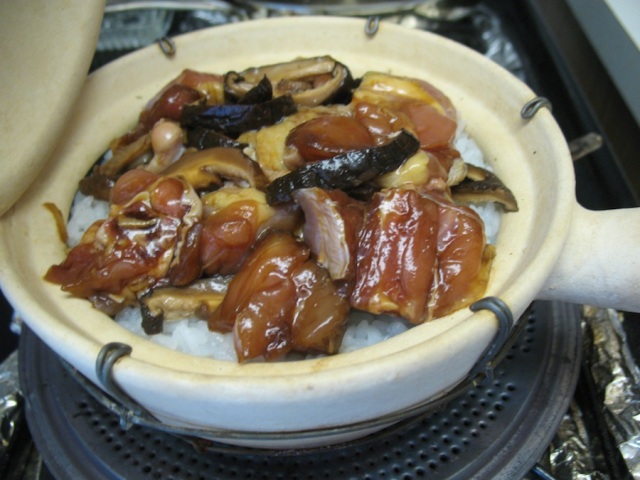
Add toppings onto the rice once it has set, this is just over 10 minutes after rice has boiled. As you might be able to see, the rice looks almost cooked already. In hindsight I should have added the topping a little earlier (see below for more info). Normally, if you still have good heat and steam coming off the rice, the topping will cook through in an additional 10-15 minutes. If you hear the rice starting to crackle on the bottom, you might have to turn your heat down even more.
While my baozai fan turned out really delicious with nicely paired flavors, the rice was a touch overcooked. The reason for that is I put my topping on the rice too late, and my topping was pretty thick. I turned the heat way down, and the chicken was not cooking through. It was almost a tragic situation, and I decided than rather risk burning the rice and/or making a porridge block of rice, I should take the whole thing under the broiler. The chicken then cooked through successfully (and it even browned a bit).

Beautiful, David!
LikeLiked by 1 person
So that’s what those cute clay pots are for! I wander through the markets so blindly because I don’t speak Chinese. Everything you post is answering questions I’ve had. (Except for the Uigar meat pies. I told my kid that they lick the bottoms of the raw pies to stick them onto the sides of the pot. Well, maybe 3000 years ago… she didn’t believe me anyway)
LikeLiked by 1 person
Hello David, I hope all is well. I just saw this yummy post of yours. When you posted this recipe, I was in process of migrating my blog to self-hosting and missed it some how. The move was quite a process and I am still re-loading my photos, which did not go through. My late appreciation for the mention. Please visit my new vamped up blog someday. 🙂
LikeLiked by 1 person